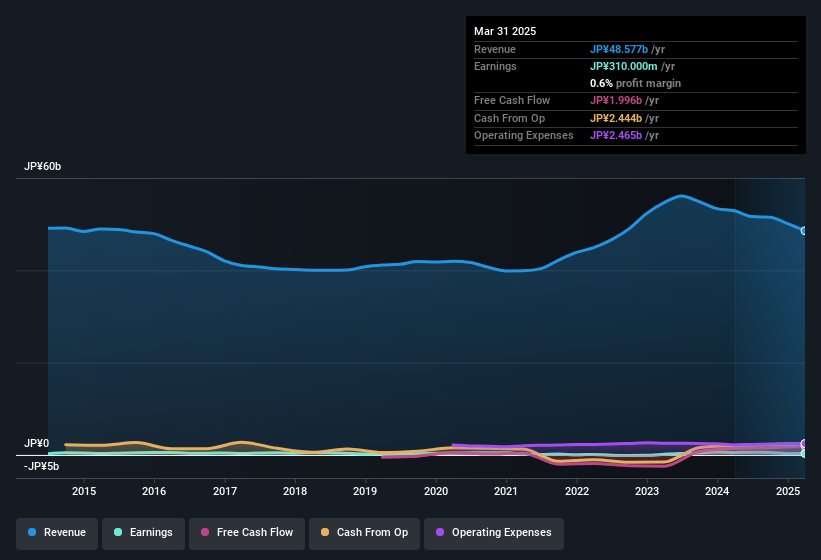Nichiwa Sangyo's (TSE:2055) Soft Earnings Are Actually Better Than They Appear

Shareholders appeared unconcerned with Nichiwa Sangyo Co., Ltd.'s (TSE:2055) lackluster earnings report last week. We did some digging, and we believe the earnings are stronger than they seem.

A Closer Look At Nichiwa Sangyo's Earnings
In high finance, the key ratio used to measure how well a company converts reported profits into free cash flow (FCF) is the accrual ratio (from cashflow). In plain english, this ratio subtracts FCF from net profit, and divides that number by the company's average operating assets over that period. The ratio shows us how much a company's profit exceeds its FCF.
Therefore, it's actually considered a good thing when a company has a negative accrual ratio, but a bad thing if its accrual ratio is positive. While having an accrual ratio above zero is of little concern, we do think it's worth noting when a company has a relatively high accrual ratio. To quote a 2014 paper by Lewellen and Resutek, "firms with higher accruals tend to be less profitable in the future".
For the year to March 2025, Nichiwa Sangyo had an accrual ratio of -0.12. That implies it has good cash conversion, and implies that its free cash flow solidly exceeded its profit last year. In fact, it had free cash flow of JP¥2.0b in the last year, which was a lot more than its statutory profit of JP¥310.0m. Nichiwa Sangyo's free cash flow improved over the last year, which is generally good to see. Having said that, there is more to the story. The accrual ratio is reflecting the impact of unusual items on statutory profit, at least in part.
View our latest analysis for Nichiwa Sangyo
Note: we always recommend investors check balance sheet strength. Click here to be taken to our balance sheet analysis of Nichiwa Sangyo.
The Impact Of Unusual Items On Profit
Nichiwa Sangyo's profit was reduced by unusual items worth JP¥644m in the last twelve months, and this helped it produce high cash conversion, as reflected by its unusual items. This is what you'd expect to see where a company has a non-cash charge reducing paper profits. While deductions due to unusual items are disappointing in the first instance, there is a silver lining. When we analysed the vast majority of listed companies worldwide, we found that significant unusual items are often not repeated. And, after all, that's exactly what the accounting terminology implies. In the twelve months to March 2025, Nichiwa Sangyo had a big unusual items expense. All else being equal, this would likely have the effect of making the statutory profit look worse than its underlying earnings power.
Our Take On Nichiwa Sangyo's Profit Performance
In conclusion, both Nichiwa Sangyo's accrual ratio and its unusual items suggest that its statutory earnings are probably reasonably conservative. After considering all this, we reckon Nichiwa Sangyo's statutory profit probably understates its earnings potential! If you'd like to know more about Nichiwa Sangyo as a business, it's important to be aware of any risks it's facing. At Simply Wall St, we found 3 warning signs for Nichiwa Sangyo and we think they deserve your attention.
Our examination of Nichiwa Sangyo has focussed on certain factors that can make its earnings look better than they are. And it has passed with flying colours. But there is always more to discover if you are capable of focussing your mind on minutiae. For example, many people consider a high return on equity as an indication of favorable business economics, while others like to 'follow the money' and search out stocks that insiders are buying. While it might take a little research on your behalf, you may find this free collection of companies boasting high return on equity, or this list of stocks with significant insider holdings to be useful.
Valuation is complex, but we're here to simplify it.
Discover if Nichiwa Sangyo might be undervalued or overvalued with our detailed analysis, featuring fair value estimates, potential risks, dividends, insider trades, and its financial condition.
Access Free AnalysisHave feedback on this article? Concerned about the content? Get in touch with us directly. Alternatively, email editorial-team (at) simplywallst.com.
This article by Simply Wall St is general in nature. We provide commentary based on historical data and analyst forecasts only using an unbiased methodology and our articles are not intended to be financial advice. It does not constitute a recommendation to buy or sell any stock, and does not take account of your objectives, or your financial situation. We aim to bring you long-term focused analysis driven by fundamental data. Note that our analysis may not factor in the latest price-sensitive company announcements or qualitative material. Simply Wall St has no position in any stocks mentioned.
About TSE:2055
Nichiwa Sangyo
Manufactures and processes compound feed products in Japan.
Flawless balance sheet established dividend payer.
Market Insights
Community Narratives




